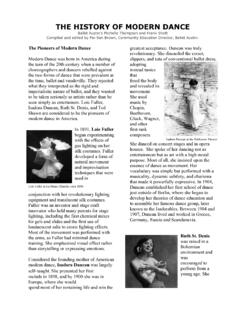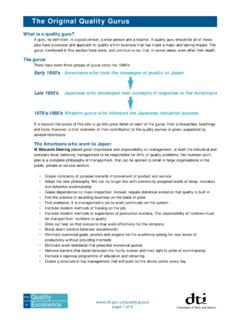Transcription of AUTHOR Pardee, Ronald L. TITLE PUB DATE NOTE 24p. - ed
1 DOCUMENT RESUME. ED 316 767 .G 022 314. AUTHOR pardee , Ronald L. TITLE Motivation theories of Maslow, Herzberg, McGregor &. McClelland. A Literature Review of Selected theories Dealing with Job Satisfaction and Motivation. PUB DATE Feb nO. NOTE 24p. PUB TYPE Information Analyses (070) -- Reports - General (140). EDRS PRICE MF01/PC01 Plus Postage. DESCRIPTORS *Job Satisfaction; *Motivation; Organizational Development; Quality of Working Life; *Rewards; Self Actualization IDENTIFIERS Motivation theories ABSTRACT. Job satisfaction, motivation, and reward systems are included in one area of organizational theory. The strongest influence in this area is motivation because it overlaps into both of the other two components. A review of the classical literature on motivation reveals four major theory areas: (1) Maslow's Hierarchy of Needs; (2) Herzberg's Motivation/Hygiene (two factor) Theory; (3).
2 McGregor's X Y theories ; and (4) McClelland's Need for Assessment Theory. Maslow states that people are motivated by unmet needs whici are in a hierarchical order that prevents people from being motivated by a need area unless all lower level needs have been met. Herzberg states that satisfaction and dissatisfaction are not on the same continuum and are therefore not opposites. He further states that the motivational factors can cause satisfar _Lon or no satisfaction while the hygiene factors cause dissatisfaction when absent and no dissatisfaction when present, both having magnitudes of strength. McClelland's need for achievement underlies Maslow's self-actualization. McGregor's Theory Y matches much of Maslow's self-actualization level of motivation. It is based on the assumption that self-direction, self-control, and maturity control motivation. Reward systems must correspond to intrinsic factors if employees are to be motivated.
3 Satisfying extrinsic factors is an all too commonly attempted method for motivating workers, but theory shows that these efforts cannot lead to motivated workers. ( AUTHOR /ABL). **g* **. Reproductions supplied by EDRS are the best that can be made from the original document. **..11. DEPARTMENT OP EDUCATION. "PERMISSION TO REPRODUCE THIS. Office of Educational Research and Improvement MATERIAL HAS BEEN GRANTED BY. iUCATIONAL RESOURCES INFORMATION. CENTER (ERIC). This document has been reproduced as received from the person or organization originating it Minor changes have been made to improve reproduction Quality CIO. Points of view or opinions stated in thisdocu. TO THE EDUCATIONAL RESOURCES. ment do not necessarily represent thew INFORMATION CENTER (ERIC).". OERI position or policy LITERATURE REVIEW. Motivation theories of Maslow, Herzberg, McGregor & McClelland A Literature Review of Selected theories Dealing With Job Satisfaction and Motivation by Ronald L.
4 pardee February 1990. BEST COPY AVAILABLE. SYNOPSIS. OF. SELECTED MOTIVATIONAL theories . by Ronald L. pardee Job Satisfaction, Motivation & Reward Systems are included in one area of Organizational Theory. The strongest influence in this area is Motivation because it overlaps into both of the other two components. A review of classical literature and recent theory on motivation reveals four major theory areas: (1) Maslow's Hierarchy of Needs, (2) Herzberg's Motivation/Hygiene (two factor) Theory, (3) McGregor's X Y theories , and (4) McClel- land's Need for Achievement Theory. Maslow states that people are motivated by unmet needs which are in a hierarchical order that prevents us from being motivated by a need area unless all lower level needs have been met. Herzberg states that satisfaction and dissatisfaction are not on the same continuum and are therefore not opposites. He further states that the motivational factors can cause satisfaction or no satisfaction while the hygiene factors cause, dissatisfaction when absent and no dissatisfaction when present, both having magnitudes of strength.
5 This theory was developed from an industrial setting and some critics question its validity outside of that area, particularly if the critical incident method is not used for data collection. McClelland's need for achievement underlies Maslow's self actualization. The similarities to Herzberg are that high achievers tend to intersted in Herzberg's motivators while low achievers are more concerned about hygiene McGregor's Theory Y matches much of Maslow's self actualiza- tion level of motivation. It is based on the assumption that self-direction, self-control, and maturity control motivation. Reward systems must correspond to intrinsic factors if employees are to be motivated. Satisfying extrinsic factors is an all to commonly attempted method for motivating workers, but theory shows that these efforts cannot lead to motivated workers. Table of Contents 1. Introduction 1. 2. Definitions of Motivation 2.
6 3. General Discussion of Motivation O 3. 4. Overview of theories 4. Maslow Herzberg McClelland 5. Motivation in the Workplace 11. 6. Comparison of theories 13. 7. Summary & Conclusions .. 15. ii 2. Introduction Motivation is such an important element in improving work productivity, every educational administrator needs to have a firm understanding of how it relates to job satis- faction and reward systems. Based on numerous state and national studies concerning the condition of schools, a great deal of time, energy, and effort is expended by educational administrators trying to improve the effective- ness and efficiency of educational delivery systems. Understanding job satisfaction and work motivation can be key elements to improving educational productivity. A review of the literature on motivation from three of the foremost theorists on motivation, Maslow, Herzberg and McClelland, indicates that typical reward system used in public schools satisfies only the hygiene factors and does not address the higher level needs that truly motivate people.
7 Changing how we attempt to motivate employees requires a deeper understanding of these two motivational theories . The purpose of this literature review is to present an overview of three of the theories that explain motivation in the workplace and address the factors that contribute to job satisfaction (motivation) or cause job dissatisfaction. The classic theories of motivation from Maslow, Herzberg and McClelland presented in this paper focus on how each theory 3. supports the other and how they are applicable in the workplace. Definitions of Motivation A motive what prompts a person to act in a certain way or at least develop an inclination for specific behavior (Kast and Rosenzweig 1985, 296), "Motivation" can be defined as those forces within an individual that push or propel him to satisfy basic needs or wants (Yorks 1976, 21). The level of needs will determine what rewards will satisfy an employee.
8 According to Dessler, most psychologists believe that all motivation is ultimately derived from a tension that results when one or more of our important needs are unsatisfied (Dessler 1986, 332). Maslow also states that "Only unsatisfied needs provide the sources of motiva- tion; a satisfied need creates no tension and therefore no motivation". (Burke 1987, 32). 2. It is common that three qualities are included in most definitions of motivation: (1) it is a presumed internal force, (2) that energizes for action, and (3) determines the direction of action (Russell 1971, 5) . Thus far, the motivational process has been viewed as a decision-making process which takes place within the employee (Aldag 1979, 27). Vroom defines motivation as a process governing choices made by persons among alternative forms of voluntary activity (Hamner and Organ 1978, 142). Motivators are the 4. factors that arouse, direct and sustain increased perform- ance (Duttweiler 1986, 371).
9 General Discussion of Motivation Essentially, three factors explain why some employees are motivated to work, while others are not: 1) The motivation to work varies widely in people. 2) In the past decade, there has been a significant change in many employees' attitudes toward work. 3) The increase in various government social support programs has contributed significantly to the decline in work motivation in many people (Stanton 1983, 211) . The conceptual underpinnings of the various motiva- tional principles put forth by psychologists were predicated on the fact that America had a powerful, impressive, and industrial machine that offered the prospect of considerable prosperity for all of its citizens (Stanton 1983, 210). However, while the rest of the world seemed hell-bent on becoming more productive, much of our work force dropped the work ethic as though it were something to be ashamed of.
10 Instead of striving for superior perform- ance, their goal was more pay and less work (Rogers and Levey 1987, 7). In addition to employees who are no longer easily motivated, the employers who subscribe to the Protestant- ethic have no appreciation for their subordinates' hygiene needs, and create employee dissatisfaction as a consequence (Herzberg 1976, 92) . 5. Other theorists look at workaite motivation different- ly. An example is McGregor's Theory Y which postulates that people can be basically self - directed and creative at work if properly motivated (Hersey and Blanchard 1982, 48). Overview of theories Maslow's Hierarchy of Needs Abraham Maslow believed that man is inherently good and argued that individuals possess a constantly gro 'hg inner drive that has great potential. The needs hierarchy system, devised by Maslow (1954), is a commonly used scheme for classifying human motives.













